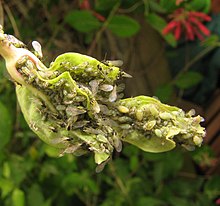Hyadaphis
Appearance
| Hyadaphis | |
|---|---|

| |
| Hyadaphis sp. on trumpet honeysuckle | |
| Scientific classification | |
| Domain: | Eukaryota |
| Kingdom: | Animalia |
| Phylum: | Arthropoda |
| Class: | Insecta |
| Order: | Hemiptera |
| Suborder: | Sternorrhyncha |
| Family: | Aphididae |
| Subfamily: | Aphidinae |
| Tribe: | Macrosiphini |
| Genus: | Hyadaphis Kirkaldy, 1904 |

Hyadaphis is a genus of aphids in the family Aphididae. There are about 19 described species in Hyadaphis.[1][2][3]
Species
[edit]These 19 species belong to the genus Hyadaphis:
- Hyadaphis agabiformis (Nevsky, 1928)
- Hyadaphis albus (Monzen, 1929)
- Hyadaphis anethi Nieto Nafría, Pérez Hidalgo & P.A.Brown, 2016
- Hyadaphis bicincta Börner, 1942
- Hyadaphis bupleuri Börner, 1939
- Hyadaphis bupleuriphila Barjadze & Özdemir, 2018
- Hyadaphis coerulescens
- Hyadaphis coriandri (Das, B.C., 1918) (coriander aphid)
- Hyadaphis ferganica
- Hyadaphis foeniculi (Passerini, 1860) (fenel aphid)
- Hyadaphis galaganiae
- Hyadaphis haplophylli Kadyrbekov, 2005
- Hyadaphis levantina Nieto Nafría, Pérez Hidalgo & P.A.Brown, 2016
- Hyadaphis mongolica Szelegiewicz, 1969
- Hyadaphis parva Nieto Nafría, Pérez Hidalgo & P.A.Brown, 2016
- Hyadaphis passerinii (Del Guercio, 1911)
- Hyadaphis polonica Szelegiewicz, 1959
- Hyadaphis tataricae (Aizenberg) (honeysuckle aphid)
- Hyadaphis veratri Shinji, 1942
References
[edit]- ^ "Hyadaphis". GBIF. Retrieved 1 April 2019.
- ^ "Hyadaphis Genus Information". bugguide.net. Retrieved 1 April 2019.
- ^ Favret, Colin (2018). "Aphid species file online, Version 5.0". Retrieved 1 April 2019.
Further reading
[edit]- Foottit, R.G.; Halbert, S.E.; Miller, G.L.; Maw, E.; et al. (2006). "Adventive aphids (Hemiptera: Aphididae) of America north of Mexico". Proceedings of the Entomological Society of Washington. 108: 583–610. ISSN 0013-8797.
- Skvarla, Michael J.; Halbert, Susan E.; Foottit, Robert G.; Jensen, Andrew S.; et al. (2017). "An Update to the Adventive Aphids (Hemiptera: Aphidoidea) of America North of Mexico, with Notes on Intercepted Species". Proceedings of the Entomological Society of Washington. 119: 90–111. doi:10.4289/0013-8797.119.1.90. ISSN 0013-8797.
